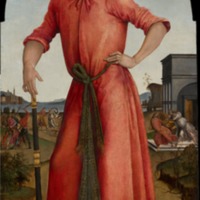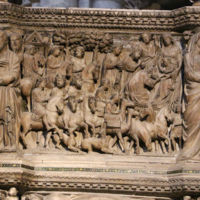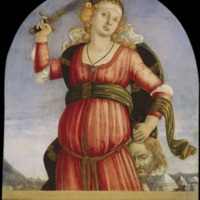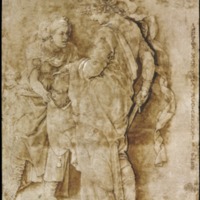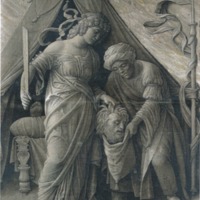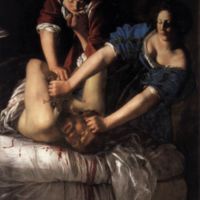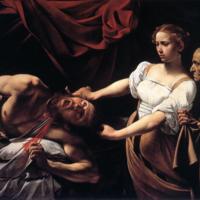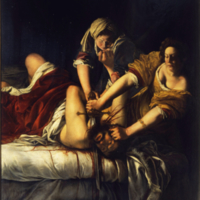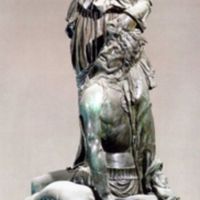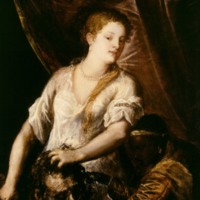Browse Items (375 total)
Joseph of Egypt
Tags: bodies of water, cisgender female onlooker(s) or peripheral figure(s), cisgender male central figure(s), cisgender male onlooker or peripheral figure(s), cityscape, figure(s) looking directly at the viewer, Gender, history—Biblical subject, history—Biblical subject—Old Testament, landscape, locations outside Italy, Siena, Sienese installation/viewing context, Sienese patron, subject location(s) outside Italy, violence, weapon(s), women and gender minorities
Journey of the Magi
Tags: African(s), animal(s), beards, BIPOC, central person(s) of color, cisgender female central figure(s), cisgender male central figure(s), cisgender male onlooker or peripheral figure(s), history—Biblical subject, history—Biblical subject—New Testament, locations outside Italy, men of color, onlooker(s) or peripheral person(s) of color, Pisa, Pisan artist, plant(s), Race, servant(s) or slave(s), Siena, Sienese installation/viewing context, subject location(s) outside Italy, women and gender minorities
Judith
Tags: cisgender female central figure(s), Gender, history—Biblical subject, history—Biblical subject—Old Testament, jewelry, landscape, locations outside Italy, Siena, Sienese installation/viewing context, Sienese patron, subject location(s) outside Italy, tent(s), weapon(s), women and gender minorities
Judith and her servant, Abra
Tags: African(s), BIPOC, central person(s) of color, cisgender female central figure(s), costume or fashion as a marker of racial or ethnic identity, figure(s) seen from behind, history—Biblical subject, history—Biblical subject—Old Testament, intersectionality, jewelry, locations outside Italy, Mantua, Padua, Paduan artist, Race, servant(s) or slave(s), subject location(s) outside Italy, weapon(s), women and gender minorities, women of color
Judith and her servant, Abra
Tags: African(s), BIPOC, central person(s) of color, cisgender female central figure(s), flag(s), history—Biblical subject, history—Biblical subject—Old Testament, intersectionality, locations outside Italy, Mantua, Padua, Paduan artist, Race, servant(s) or slave(s), subject location(s) outside Italy, tent(s), weapon(s), women and gender minorities, women of color
Judith and Holofernes
Tags: beards, cisgender female central figure(s), cisgender male central figure(s), Gender, history—Biblical subject, history—Biblical subject—Old Testament, locations outside Italy, Rome, self-portraiture, servant(s) or slave(s), subject location(s) outside Italy, violence, weapon(s), woman artist, women and gender minorities
Judith and Holofernes
Tags: beards, bisexual, cisgender female central figure(s), cisgender male central figure(s), gay, Gender, history—Biblical subject, history—Biblical subject—Old Testament, jewelry, LGBTQ+ artist, locations outside Italy, Rome, servant(s) or slave(s), sexual orientation minorities, subject location(s) outside Italy, violence, weapon(s), women and gender minorities
Judith and Holofernes
Tags: beards, cisgender female central figure(s), cisgender male central figure(s), Gender, history—Biblical subject, history—Biblical subject—Old Testament, locations outside Italy, Rome, servant(s) or slave(s), subject location(s) outside Italy, violence, weapon(s), woman artist, women and gender minorities
Judith and Holofernes
Tags: beards, cisgender female central figure(s), cisgender male central figure(s), costume or fashion as a marker of racial or ethnic identity, Florence, Florentine installation/viewing context, Florentine patron, gay, Gender, history—Biblical subject, history—Biblical subject—Old Testament, LGBTQ+ artist, locations outside Italy, nudes, sexual orientation minorities, subject location(s) outside Italy, violence, weapon(s), women and gender minorities
Judith with the Head of Holofernes
Tags: African(s), BIPOC, cisgender female central figure(s), history—Biblical subject, history—Biblical subject—Old Testament, intersectionality, jewelry, locations outside Italy, onlooker(s) or peripheral person(s) of color, Race, servant(s) or slave(s), subject location(s) outside Italy, Venice, weapon(s), women and gender minorities, women of color
